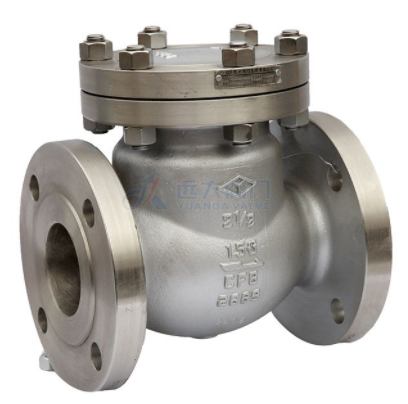The Ultimate Guide to Check Valves
Check valves are responsible for ensuring proper flow within a fluid system. Also known as non-return or one-way valves, check valves are specifically designed to prevent reverse flow within a pipeline.

How Does a Check Valve Work?
To really understand the question: how does a check valve work, you must first understand how they’re constructed. Most check valves are made with a body, seat, disc, and cover. Other types of check valves may come with additional parts like a spring, ball, stem, or hinge pin depending on their design.
Check valves are controlled based on a system’s flow velocity. Once the system reaches the cracking pressure or the minimum upstream pressure needed for the valve to operate, the disc will lift and allow the fluid to pass through. If the fluid pressure decreases or if the flow direction starts to reverse, the disc will automatically close the valve to keep fluid from flowing through. This helps to prevent backflow.
Since check valves rely on the pressure and flow velocity of the fluid in the system to operate, they can usually work without any automation or human interaction. With that said, check valves aren’t typically designed with any form of exterior operation mechanisms like a lever or handle.
Check Valve Applications
Now that you understand the basics of; how does a check valve work, we review the common applications. Check valves are commonly used for industrial pumps and fluid systems in the oil and gas industry. Chemical and power plants also use check valves to prevent reverse flow in advanced machinery. On top of that, check valves can be installed in many process systems to keep fluids of different pressures separated.
Check Valve Selection
While all check valves are designed to ensure proper flow direction, they’re not all the same. There are many types of check valves, and each is intended for specific application and service conditions.
The ideal check valve should be made with a material that’s compatible with the type of liquid or gas you’re working with. You should also make sure that you select the appropriate type of check valve (e.g. spring-assisted in-line check valve, silent check valve) for the application.
3 Common Problems in Check Valve Selection
Water Hammer
Water hammer is one of the most common check valve problems. A water hammer is a pressure surge that’s caused when a liquid or gas is forced to stop or change direction suddenly and often occurs when a valve is suddenly closed at the end of a pipeline system. This can result in both noise and vibration, which can, in turn, lead to damage and additional maintenance or repair costs.
Water hammer can be prevented, however, by using a faster-closing check valve that stops the pressure surges and shock waves that can damage and rupture equipment. Our silent check valves in particular are known for their effectiveness in preventing and in many cases eliminating water hammers.
Reverse Flow
Reverse flow is another common check valve problem and can be extremely costly, especially when it occurs at the discharge of a pump, causing the pump to spin backward.
A fast-closing and tight shut-off valve are necessary to prevent this problem, and the right spring-assisted in-line check valve will do just that, eliminating reverse flow.
Oversizing
If there is a lot of valve chatter—opening and closing of the valve repeatedly—chances are it’s due to oversizing. What’s important to remember is that check valves should be sized for the application, and not for the line size. You want the disc to be stable against the internal stop in the open position or fully closed; this will result in no repeated fluttering, and therefore no premature failure.
Keep these common problems in mind, select the right check valve for your application, and your check valves will last longer and work more effectively for your applications.
Takeaways
Most importantly, you need to ensure that the check valve you choose is the correct size for the application, not the line size. Selecting a valve that’s sized for the application keeps the disc stable on the internal stop when the valve is open or closed. This helps to keeps the disc from fluttering and extends the valve’s overall service life.
We are a check valve supplier, please feel free to contact us if you need them!